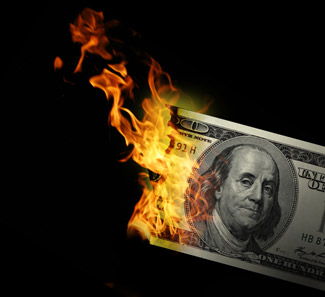 Things are heating up at JP Morgan Chase. The Dodd-Frank law has enabled regulators to ratchet up their queries regarding massive trading losses at this venerable institution, the best of its class. Some pundits minimize the loss (estimated to possibly balloon to $6 billion) as a function of the fact that Chase is a $2.3 trillion enterprise. One thing, frankly, has nothing to do with the other. This type of thinking is just a marketing ploy geared to sooth the rage and pain of shareholders. It doesn’t really hold water.
Things are heating up at JP Morgan Chase. The Dodd-Frank law has enabled regulators to ratchet up their queries regarding massive trading losses at this venerable institution, the best of its class. Some pundits minimize the loss (estimated to possibly balloon to $6 billion) as a function of the fact that Chase is a $2.3 trillion enterprise. One thing, frankly, has nothing to do with the other. This type of thinking is just a marketing ploy geared to sooth the rage and pain of shareholders. It doesn’t really hold water.
Trading desks are centers of “pride” and “adventure” at large institutions in terms of bragging rights and “big scores,” according to the lively group of traders I’ve treated. Trivializing any loss is an example of penultimate rationalization, and confirms the fact that Wall Street still does not comprehend what is truly important to Main Street. Main Street yearns for integrity, transparency accountability, sustainability, and clarity.
Human Beings are Symbolic Thinkers
No matter how you slice it, $6 billion dollars is not chump change. Many sound, creative, and worthy humanitarian projects can be underwritten for that kind of money. Many pundits are “master of their own universe and experts” when it comes to rationalization and denial. So be it. But the rest of us are symbolic thinkers, and we need to have confidence. We need to believe and trust that the CEO of companies we own conjointly, and his management team, represent and embrace similar ideals, and values that we do. Trust in the stewardship of our companies is not only warranted, but deserved. Deception and rationalization are easily fueled and lubricated with OPM (Other People’s Money).
Trust and money are among the two most important words/needs/concepts in the English language, or any other language for that matter. We are all super sensitive to betrayal. History, and current life, all too poignantly has shown us how money corrupts, builds, sustains, creates, unites, and concerns us all. Money is the backstory of history; it has created community, civilization and democracy. Niall Ferguson’s The Ascent of Money documents this evolution quite well.
Current Fact Check
The CFT’s (Commodity Futures Trading Commission) investigation of JP Morgan Chase can make history. Since, the Dodd-Frank Act of 2010, the tools that the CFTC were granted to extend oversight can actually be utilized. The Justice Department and the SEC are also probing Chase in an effort to discover what actually happened. The CFTC now has the authority and jurisdiction to investigate fraud in the derivatives and swaps markets.
JP Morgan’s CEO has an appointment with US Senate lawmakers on June 13. Lawmakers are particularly interested in the Volcker Rule which focuses on barring banks from trading with their own money. Frankly, it’s our money: shareholder assets. I happen to have a significant stake in JPM as well as numerous personal and business accounts with the bank. Everything is relative, but Chase represents an important portion of my portfolio and my life. I am not a market player; I only aspire to be a market survivor.
The Issues at Hand
What actually happened at Chase? Who knew what, did what, and revealed what at what points in time? Were managers-in-charge informed adequately vis a vis all risk management issues? Was “bet strategy” reviewed and approved? Was the CEO kept in the information-loop properly? Harry Truman claimed and lived by the code: “The buck stops here.” It certainly does in the money-mad world of the Street, and Chase’s CEO is the last man standing. All remains to be unraveled, and then revealed.
JPM’s market value has dropped nearly $30 billion since the announcement of their derivatives trading losses. Where will it bottom out? As the losses grow, how will core equity value of the company be impacted? And will there be a variety of ripple effects within the company?
Cognitive Dissonance
The cognitive dissonance index must be soaring at 270 Park Avenue in New York City, “The Financial Capital of the World.” Cognitive dissonance is an all too human phenomenon wherein discomfort caused by conflicting emotions, values , beliefs, or ideas simultaneously in one’s mind (and workplace) must be balanced in some manner in order for people to be able to continue to function, and work. The classic example is “sour grapes.” Aesop’s fox is hungry and spies the grapes, but unable to reach them the fox decides he doesn’t want them anyway, and in fact he really wasn’t hungry after all. Chase trades went sour, and now the resolution/rationalization process comes into play in order to satiate the appetite and the angst of the executive management team, and shareholders, for closure and understanding.
Confusion, avoidance, denial, and rationalization can run rampant as Chase employees try to keep on producing, and also maintain their dignity as they attempt a fearless inventory of “what actually went down.” Cognitive dissonance mechanisms soothe and protect us only to a point. Intellectualization and rationalization can only go so far. Virtue and honor will be tested heavily during this moment of JPM’s history. How Street and business analysts assess the drama should intrigue us all.
How will Chase employees, management, and the CEO juggle/master/handle their cognitive dissonance, and their anxiety and fear as Chase sizzles? How will morale and productivity be impacted? HR could be humming, and industry recruiters will be on the prowl. A corporation is a world unto its own with many internal fiefdoms.
The best leaders inspire, instill trust and confidence, and must keep their people “warm, safe and happy.” Uncertainty within a company, and on the Street, can be viral and destructive. Full disclosure and corrective action are necessities when problems of epic proportion are ignited. Jamie Dimon and Chase are at the epicenter of a Big Apple summer wildfire.
As the layers of this remarkable story unfold, readers will be “posted” accordingly. We have the makings of an intriguing set of case studies, from a myriad of vantage points, for our best MBA Reviews up front, close, and personal. The players, the themes, the costs, the issues, and JP Morgan Chase’s corporate reputation, in this “age of skepticism,” is at stake. Peter Firestein’s Crisis of Character is a critical read for Chase’s corporate reputation risk management team. We will see what Chase is made of over the next several weeks and months.
To contact Christopher Bayer directly, please email Christopher.Bayer@TheShareholderActivist.com.








